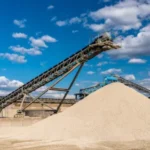The Essential Guide to Shale Inhibitors in the Oil and Gas Industry

Shale inhibitors are a crucial component of modern drilling fluids, acting as a safeguard against the challenges posed by reactive shale formations. These chemical additives are engineered to maintain wellbore stability, ensuring drilling operations are efficient, safe, and cost-effective. Without them, drillers would face significant risks, including wellbore collapse, stuck pipes, and expensive downtime.
What Are Shale Inhibitors?
Shale inhibitors are specialized chemicals added to drilling fluids to prevent the hydration, swelling, and dispersion of reactive clay minerals found in shale formations. Reactive shales, which can contain minerals like smectite and illite, readily absorb water, leading to a host of problems that can compromise the integrity of the wellbore and drilling equipment. The use of these additives has become a standard practice in oil and gas operations worldwide, from the complex formations of the Gulf of Mexico to deepwater fields.
Why Shale Swelling is a Problem
When drilling through reactive shale, water from the drilling fluid can be absorbed by the clay minerals. This absorption causes the shale to swell, expand, and weaken, creating several operational hazards:
- Wellbore Collapse: The swelling and weakening of the formation can cause the wellbore walls to crumble, leading to partial or complete collapse.
- Bit Balling: Sticky, swollen clay can accumulate on the drill bit, preventing it from cutting effectively and significantly reducing the rate of penetration (ROP).
- Hole Enlargement: As the shale swells and sloughs off, the drilled hole can become much larger than the diameter of the drill bit, making it difficult to control the wellbore and increasing the risk of getting stuck.
- Stuck Pipes: Swollen, dislodged shale can fall and pack around the drill pipe, trapping it in the wellbore and potentially leading to the loss of expensive drilling equipment.
- Safety Hazards: Wellbore instability can also create safety risks for rig personnel due to unpredictable downhole conditions.
Types of Shale Inhibitors and Their Mechanisms
Shale inhibitors work through various chemical and physical mechanisms to counteract the effects of water on shale. The choice of inhibitor depends on factors like the type of clay, temperature, pressure, and the overall drilling fluid system.
| Type | Mechanism | Common Products/Examples |
| Cation Exchange | Non-hydrated cations displace the hydrated cations on the surface of the clay, preventing water from binding. | Potassium Chloride (KCl), Organic Cations |
| Encapsulation | A polymer or other substance forms a protective coating around the shale particles and cuttings, preventing water from reaching the clay surface. | Partially Hydrolyzed Polyacrylamide (PHPA), Asphaltic Polymers |
| Permeation Rate Reducers | These additives increase the viscosity of the drilling fluid, slowing the rate at which water can permeate into the shale formation. | Polyglycerols, Methyl-Glucoside |
| Osmotic Transfer Blockers | Salt solutions create an osmotic pressure gradient that pulls water out of the shale or prevents it from entering. | Sodium Chloride (NaCl), Calcium Chloride (CaCl2), Potassium Formate |
| Pore Plugging | Microgels or plastic particles physically seal the microscopic fractures and pores in the shale, blocking water entry. | Microgels, Cloud Point Glycols |
| Surface Adsorption | Organic molecules with an affinity for clay surfaces adsorb onto the shale layers, forming a barrier that repels water molecules. | Polyamines, Amine-Capped PAGs |
| Inter-Particle Cementation | Colloidal particles act as a binder, filling tiny pores and fractures to strengthen the shale and prevent dispersion. | High-Lime Muds, Silicate Solutions |
Key Ingredients and Modern Developments
The industry has evolved from traditional, less environmentally friendly inhibitors to advanced, high-performance polymers.
- Traditional Inhibitors: Initially, simple salts like potassium chloride (KCl), calcium chloride (CaCl2), and sodium silicate were used. While effective, they often had limitations in high-temperature or high-salinity environments.
- Organics and Polymers: The development of organic polymers like polyamines, PHPA, and polyglycols marked a significant leap. These materials offer improved performance, lower toxicity, and are more compatible with a wider range of mud systems.
- Polyamine Inhibitors: These are a notable modern development. They are known for being environmentally friendly, effective at low concentrations, highly stable under extreme conditions, and for having a reduced environmental footprint. Their ability to encapsulate clay and work through surface adsorption makes them highly efficient.
- Latest Innovations: Cutting-edge research is focused on hyperbranched and crosslinked polymers and polyionic liquids. These next-generation inhibitors offer enhanced temperature and salt resistance, making them ideal for challenging ultra-deep and high-pressure/high-temperature (HPHT) wells.
Operational Advantages and Real-World Results
The use of shale inhibitors translates directly into tangible operational and economic benefits for drilling companies:
- Improved Wellbore Stability: By preventing shale swelling and sloughing, inhibitors lead to a more stable wellbore, which significantly reduces downtime and operational risks.
- Efficiency Gains: Issues like stuck pipes, drillstring torque, and hole enlargement are minimized, allowing for faster and more efficient drilling.
- Versatility: Inhibitors are compatible with various drilling fluid types, including water-based muds (WBMs), oil-based muds (OBMs), and synthetic-based muds, making them adaptable to different drilling applications.
- Performance in Extreme Conditions: Modern inhibitors are designed to perform in demanding environments with temperatures up to 350°F (175°C) and high-pressure conditions.
At Sunita Hydrocolloids, we understand the critical role that high-performance shale inhibitors play in successful drilling operations. Our advanced line of shale inhibitors is specifically engineered to address the most challenging reactive formations.
Compliance, Standards and Evaluation
The use of shale inhibitors is governed by strict industry standards to ensure safety and environmental protection. These standards include:
- ISO 13503-1: Specifies the procedure for testing drilling fluid additives.
- ISO 9001: A quality management system standard.
- API RP 13B: Recommended practices for field testing water-based drilling fluids.
- API RP 13C: Recommended practices for field testing oil-based drilling fluids.
Evaluation of shale inhibitors involves rigorous laboratory and field testing to assess their performance. Key evaluation methods include:
- Rolling Recovery Tests: Measures the percentage of shale cuttings that remain intact after being exposed to the drilling fluid under controlled conditions.
- X-ray Diffraction (XRD): Used to analyze the mineralogical changes in the shale before and after exposure to the inhibitor, providing insights into its effectiveness.
- Field Trials: Real-world tests that compare clay swelling rates, mud stability at depth, and torque reduction to validate laboratory results.
Where Are Shale Inhibitors Used?
While primarily used in drilling fluids, shale inhibitors have a broader range of applications:
- Drilling Fluids: For wells with known reactive shale formations.
- Completion and Stimulation Fluids: Used during hydraulic fracturing to protect the wellbore and surrounding formations.
- Production Fluid Treatments: To prevent formation damage during oil and gas production.
- Reservoir Drill-in Fluids: To protect sensitive reservoir zones from damage during drilling.
Conclusion
Shale inhibitors are indispensable chemicals in the oil and gas industry, acting as a critical line of defense against wellbore instability and drilling inefficiencies. Their evolution from simple salts to advanced polymers and polyionic liquids reflects a continuous effort to enhance drilling performance, improve safety, and reduce environmental impact. For drilling professionals and companies, understanding the science behind these inhibitors and their practical application is essential for mastering the challenges of modern oil and gas exploration and production.
Partner with Sunita Hydrocolloids to improve your drilling efficiency and safeguard your valuable assets with our proven, reliable, and environmentally conscious solutions.





